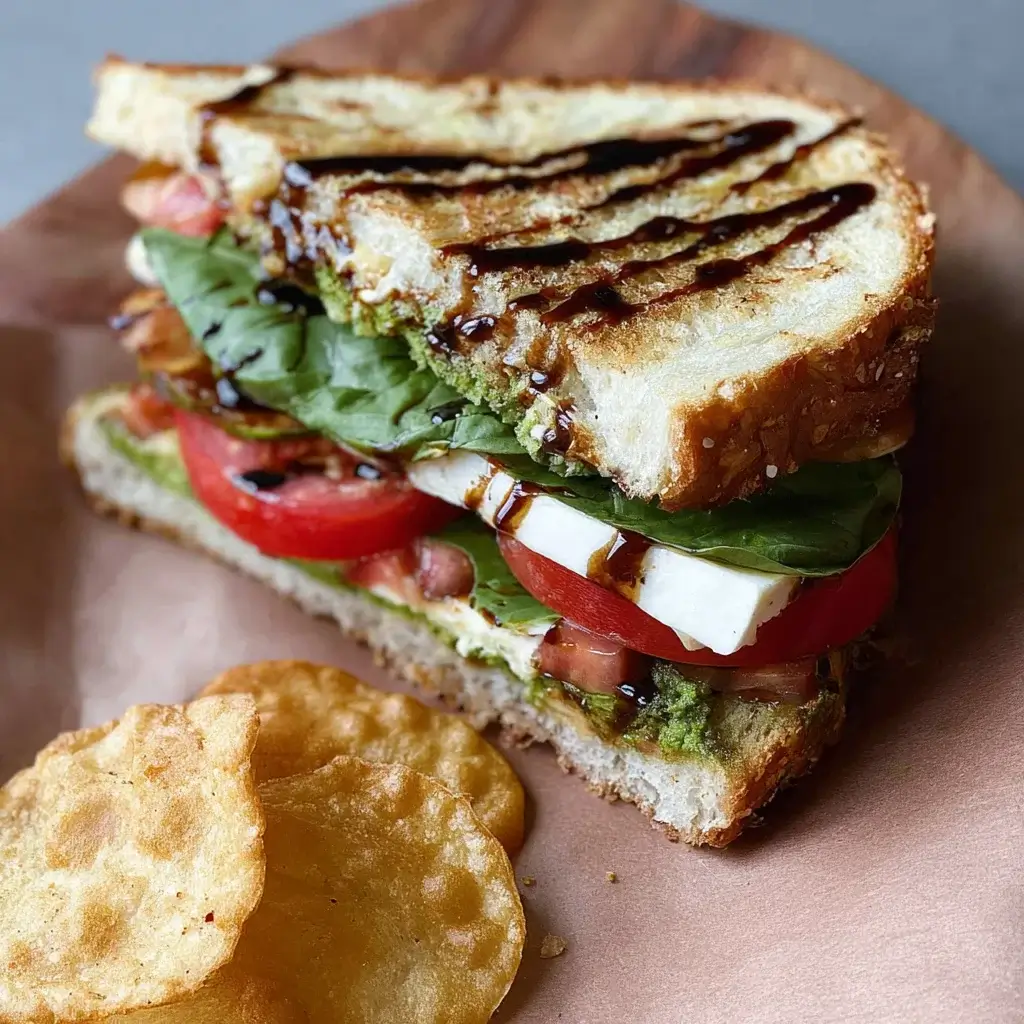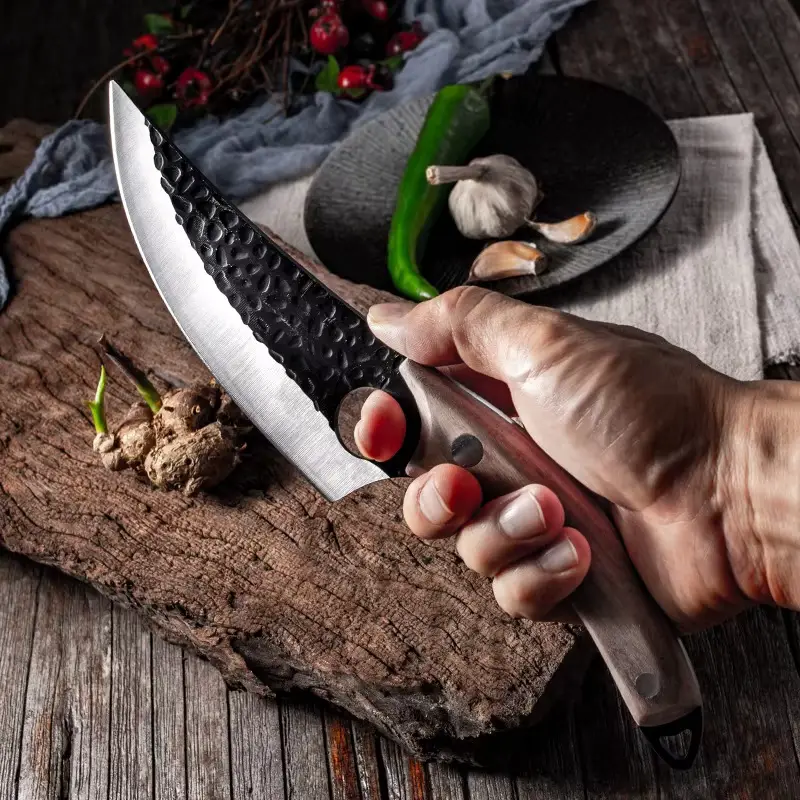There are certain foods that are so perfectly and profoundly simple, they feel less like a recipe and more like a discovery. The Caprese sandwich is one of those discoveries. I’ll never forget the first time I had a truly great one. It wasn’t in a fancy restaurant, but at a small, sun-drenched café on a trip through the Italian countryside. I was tired and hungry, and I ordered it simply because it seemed easy. What arrived was a masterpiece. It was built on a rustic, crusty bread that crackled when I picked it up. Inside, there were thick, luscious slices of sun-warmed tomato that tasted of pure earth and sunshine, layered with creamy, milky slices of fresh mozzarella that were the perfect, gentle counterpoint. Tucked between them were whole leaves of fragrant, peppery basil that perfumed every single bite. But the final touch, the stroke of genius, was a dark, syrupy drizzle of balsamic glaze that tied everything together with its complex sweet and tangy notes. It wasn’t just a sandwich; it was an experience. It was the taste of a perfect summer afternoon, a celebration of ingredients so fresh they needed no elaborate preparation. I have spent years chasing that perfect bite, and this recipe is the culmination of that quest—a way to bring that little piece of Italian sunshine into my own kitchen and share it with my family, who now agree that a well-made Caprese sandwich is one of life’s purest joys.
The Soul of Simplicity: Deconstructing the Perfect Caprese Sandwich
The magic of a Caprese sandwich lies in its minimalism. With only a handful of core ingredients, there is nowhere for mediocrity to hide. The difference between a forgettable sandwich and an unforgettable one comes down to the quality and handling of each individual component. This isn’t about complex culinary techniques; it’s about honoring the ingredients. The name itself, “Caprese,” means “of Capri,” the beautiful Italian island where this combination of tomato, mozzarella, and basil is said to have originated, a patriotic tribute to the red, white, and green of the Italian flag. To build the ultimate Caprese sandwich, we must first understand and respect its foundational pillars.
Pillar 1: The Tomato – The Heart of Summer
The tomato is the soul of the sandwich. A pale, mealy, out-of-season tomato will result in a sad, watery sandwich, no matter how good the other ingredients are. This is a dish best saved for the height of summer, when tomatoes are at their peak.
- Variety is Key: Look for large, heavy-for-their-size heirloom varieties. A Brandywine offers a perfect balance of sweetness and acidity. A Cherokee Purple brings a rich, slightly smoky flavor. A vibrant yellow or orange tomato can add a different, fruitier note. The goal is a tomato that is deeply flavorful and has a dense, meaty flesh, not one that is overly seedy or watery.
- The Sin of Refrigeration: The single greatest crime you can commit against a fresh tomato is to put it in the refrigerator. The cold temperature damages the membranes inside the fruit, halting the enzyme activity that produces its complex flavors and turning its texture dull and mealy. Always store your tomatoes at room temperature on the counter.
- The Salting Ritual: A crucial pro-tip is to slice your tomatoes, lay them on a plate, and lightly sprinkle them with kosher salt about 10-15 minutes before assembling the sandwich. The salt works through osmosis, drawing out excess water. This not only prevents a soggy sandwich but also concentrates the tomato’s natural flavor, making it taste more intensely of itself.
Pillar 2: The Mozzarella – The Creamy Counterpoint
The cheese provides the rich, creamy, and cooling contrast to the acidic tomato. The type of mozzarella you choose is non-negotiable.
- Fresh is the Only Option: This is not the time for the low-moisture, rubbery block of mozzarella used for pizza. You must use fresh mozzarella, which is typically sold in a ball or log shape and packed in water or whey. It has a soft, delicate texture and a clean, milky flavor.
- Buffalo vs. Cow’s Milk: For a truly luxurious experience, seek out Mozzarella di Bufala, made from the milk of water buffaloes. It is richer, creamier, and has a slight tang that is unparalleled. However, a high-quality fresh mozzarella made from cow’s milk (Fior di Latte) is also delicious and more widely available.
- Pat it Dry: Just as we draw moisture from the tomatoes, we must remove excess moisture from the mozzarella. After slicing, gently pat the slices dry with a paper towel. This prevents them from leaching water into the bread.
Pillar 3: The Basil – The Aromatic Soul
Basil provides the fresh, aromatic, and slightly peppery bite that cuts through the richness of the cheese and complements the tomato.
- Sweet Genovese: The best variety for a Caprese is Sweet Genovese basil, known for its large, tender leaves and a perfect balance of sweet and savory notes.
- Whole Leaves for the Win: While you can chiffonade (slice into thin ribbons) the basil, using whole, fresh leaves provides a more authentic experience. Tucking 4-5 whole leaves between the layers ensures you get that burst of herbaceous flavor in every bite. Avoid using dried basil at all costs; its flavor is completely different and will not do justice to the sandwich.
Pillar 4: The Bread – The Noble Vessel
The bread is not just a container; it is an essential textural and flavorful component that holds everything together. The wrong bread can ruin the entire experience.
- Sturdy and Crusty: You need bread with a sturdy, crisp crust and a soft, airy interior (the crumb). The crust provides a satisfying crunch and structural integrity, while the soft interior is perfect for absorbing the olive oil and balsamic glaze without falling apart.
- Top Choices:
- Ciabatta: This Italian bread is perhaps the perfect choice. Its name means “slipper” in Italian, and its rustic, slightly chewy texture and open crumb are ideal.
- Focaccia: A thick slice of focaccia, especially one seasoned with rosemary and sea salt, adds another layer of flavor and has a wonderful, yielding texture.
- Rustic Baguette: A good-quality French baguette, with its shatteringly crisp crust, is another excellent option.
Complete with Ingredients Amount
This recipe makes two large, satisfying sandwiches. The homemade balsamic glaze will yield about ¼ cup, enough for several sandwiches.
For the Homemade Balsamic Glaze:
- Balsamic Vinegar: 1 cup of good-quality balsamic vinegar of Modena. You don’t need the expensive, aged artisanal variety for this, but avoid the cheapest, watery brands.
For the Caprese Sandwiches (Serves 2):
- Bread: 1 large loaf of ciabatta (about 12 inches long), or 2 large ciabatta rolls.
- Tomatoes: 2 large, ripe heirloom or beefsteak tomatoes, sliced into ⅓-inch thick rounds.
- Fresh Mozzarella: 8 oz fresh mozzarella (preferably Mozzarella di Bufala), sliced into ⅓-inch thick rounds.
- Fresh Basil: 1 large bunch of fresh basil leaves (about 1 cup, loosely packed).
- Extra Virgin Olive Oil: 2-3 tablespoons of high-quality, fruity extra virgin olive oil.
- Kosher Salt: To taste (about ½ teaspoon for salting tomatoes).
- Freshly Cracked Black Pepper: To taste.
Instructions: Assembling Your Masterpiece
The process is simple, but the order and technique matter. We’ll start with the glaze, which can be made well in advance.
Part 1: Crafting the Homemade Balsamic Glaze (Optional but Highly Recommended)
- Choose Your Pan: Pour 1 cup of balsamic vinegar into a small, non-reactive saucepan (stainless steel is perfect). A wider pan will help it reduce faster.
- Simmer Gently: Place the pan over medium-low heat and bring it to a gentle simmer. Do not let it boil aggressively, as the sugars can burn and turn bitter. You should see small, gentle bubbles.
- Reduce: Let the vinegar simmer, uncovered, for 10-15 minutes. It will reduce in volume by about half. You’ll know it’s ready when it has thickened enough to coat the back of a spoon, leaving a clear trail when you run your finger through it. It should have a syrupy consistency, similar to maple syrup.
- Cool and Store: Remove the glaze from the heat and pour it into a small glass jar or bowl. It will continue to thicken as it cools. The glaze can be stored at room temperature in an airtight container for several weeks.
Part 2: Building the Perfect Sandwich
- Prepare the Tomatoes: Slice your tomatoes and arrange them in a single layer on a plate. Sprinkle them evenly with kosher salt and let them sit for 10-15 minutes. After resting, gently blot the excess moisture from the top with a paper towel.
- Prepare the Mozzarella and Bread: While the tomatoes are salting, slice your mozzarella and pat the slices dry. Slice your ciabatta loaf in half horizontally.
- Toast the Bread: This is a crucial step to prevent sogginess. Drizzle the cut sides of the bread with about half of your extra virgin olive oil. Place them cut-side-up on a baking sheet and toast in a 400°F (200°C) oven for 5-7 minutes, or until the edges are golden and the surface is crisp. Alternatively, you can grill them on a grill pan.
- The Assembly: Lay the toasted bread halves on your work surface. Drizzle the remaining olive oil over the bottom half.
- Layer Thoughtfully: Begin layering your ingredients on the bottom slice of bread. Start with a layer of tomatoes, then a layer of mozzarella, then a generous scattering of whole basil leaves. Repeat the layers if your bread is large enough. A classic order is Tomato-Mozzarella-Basil. This allows the creamy cheese to act as a buffer between the two wettest ingredients (tomato and basil) and the bread.
- Season the Layers: As you layer, add a light sprinkle of freshly cracked black pepper.
- The Final Drizzle: Take your cooled balsamic glaze and drizzle it generously over the top layer of ingredients.
- Crown and Press: Place the top half of the ciabatta on the sandwich and press down gently but firmly with the palm of your hand. This helps meld the flavors and makes the sandwich easier to eat.
- Let it Meld: For the absolute best flavor, let the sandwich sit for 5-10 minutes before slicing and serving. This allows the flavors to marry and the bread to soften just slightly from the juices.
- Slice and Serve: Using a sharp, serrated bread knife, slice the sandwich in half (on a diagonal for a classic deli look) and serve immediately.
Nutrition Facts
Please note that these values are an estimate and can vary significantly based on the type and amount of bread, cheese, and oil used.
- Servings: 2
- Calories per serving: Approximately 700-850 kcal
While calorie-dense due to the bread, cheese, and oil, this sandwich is packed with nutrients from whole foods, including lycopene from the tomatoes and healthy monounsaturated fats from the olive oil.
Preparation Time
- Prep Time: 20 minutes (including salting tomatoes and making glaze)
- Cook Time: 5-7 minutes (for toasting bread)
- Total Time: Approximately 25-30 minutes
How to Serve and Elevate Your Caprese Experience
While the sandwich is a perfect meal on its own, it can be the centerpiece of a wonderful light lunch or dinner.
- Classic Lunch Pairing:
- Serve with a simple side of kettle-cooked potato chips for a satisfying crunch.
- Pair with a small bowl of soup, such as a light tomato basil soup (to echo the flavors) or a chilled gazpacho in the summer.
- Elegant Presentation:
- Serve alongside a simple arugula salad dressed with lemon juice and olive oil. The peppery bite of the arugula is a perfect complement.
- Pair with a side of marinated olives and artichoke hearts for a full Mediterranean-style lunch spread.
- Perfect for Picnics:
- Assemble the sandwich, press it firmly, and wrap it tightly in parchment paper, then foil. It travels beautifully and the flavors will meld even more over time.
- Transform it into a Panini:
- Assemble the sandwich as directed (using a sturdy bread like ciabatta) and press it in a panini press or a hot skillet (weigh it down with another heavy pan) until the cheese is melted and gooey and the bread is golden brown and crisp.
5 Pro-Tips for Caprese Sandwich Perfection
- Salt Your Tomatoes. Period. This is the most transformative, non-negotiable tip. It elevates the tomato from a simple ingredient to the star of the show by concentrating its flavor and preventing a soggy sandwich.
- Use Oil as a Barrier: Before layering any ingredients, make sure the inside of your toasted bread is well-coated with a layer of high-quality extra virgin olive oil. This creates a fat barrier that helps prevent the bread from absorbing too much moisture from the other ingredients.
- Don’t Skimp on the Basil: Be generous with your fresh basil. It’s not just a garnish; it’s a primary flavor component. You want to taste its fresh, peppery bite in every mouthful. Tucking at least 8-10 large leaves into a full sandwich is a good starting point.
- Embrace the Meld: That 5-10 minute rest after assembling the sandwich is crucial. It gives the salt, oil, and balsamic time to mingle, the tomato juices to lightly soak into the very top layer of the bread’s crumb, and the cheese to come to room temperature. This small pause transforms it from a collection of ingredients into a cohesive, harmonious sandwich.
- Make Your Own Glaze: It takes 15 minutes and elevates the sandwich from good to sublime. Store-bought glazes can be overly sweet and contain corn syrup or other thickeners. A homemade reduction has a much more complex, authentic, and tangy flavor that beautifully balances the sweetness of the tomatoes and the richness of the cheese.
Frequently Asked Questions (FAQ)
1. What is the absolute best bread for a Caprese sandwich?
While several types work, the consensus among many chefs is that ciabatta is the champion. Its rustic, chewy texture, crisp crust, and airy, open crumb structure are perfectly designed to hold the juicy ingredients while absorbing just the right amount of oil and glaze without turning to mush.
2. Can I add other ingredients to my Caprese sandwich?
Absolutely! While the classic version is a testament to simplicity, a Caprese sandwich is a fantastic base for other flavors. Popular additions include:
- Pesto: A smear of fresh basil pesto on the bread adds a huge punch of flavor and an extra layer of moisture protection.
- Prosciutto or Salami: For a non-vegetarian version, add a few thin slices of Prosciutto di Parma or Genoa salami for a salty, savory kick.
- Avocado: Sliced avocado adds another layer of creaminess.
- Roasted Red Peppers: Add a sweet, slightly smoky element.
3. How can I keep my sandwich from getting soggy if I’m making it for later?
The key is moisture management. Follow these steps for a picnic-perfect sandwich: Toast the bread well. Create an oil or pesto barrier. Salt your tomatoes and pat them very dry. Pat your mozzarella very dry. The most effective trick is to pack the wet ingredients (tomatoes and mozzarella) separately and assemble the sandwich just before eating. If you must pre-assemble, wrapping it tightly in parchment paper (not plastic wrap, which traps moisture) will help.
4. Is there a big difference between regular balsamic vinegar and balsamic glaze?
Yes, a huge difference. Regular balsamic vinegar is thin and liquid, with a very sharp, acidic taste. It would make a sandwich very soggy. Balsamic glaze is simply balsamic vinegar that has been cooked down (reduced) until the water evaporates, concentrating the sugars and creating a thick, syrupy consistency with a much more balanced sweet-and-sour flavor.
5. I don’t have fresh basil. Can I use dried basil instead?
In a word: no. This is one of the few recipes where the fresh herb is absolutely essential. Dried basil has a completely different flavor profile—more minty and hay-like—and lacks the vibrant, fresh, peppery notes of its fresh counterpart. Using it would fundamentally change the character of the sandwich for the worse. It’s better to leave the basil out entirely than to use dried.

Caprese Sandwich with Balsamic Glaze recipe
Ingredients
For the Homemade Balsamic Glaze:
-
Balsamic Vinegar: 1 cup of good-quality balsamic vinegar of Modena. You don’t need the expensive, aged artisanal variety for this, but avoid the cheapest, watery brands.
For the Caprese Sandwiches (Serves 2):
-
Bread: 1 large loaf of ciabatta (about 12 inches long), or 2 large ciabatta rolls.
-
Tomatoes: 2 large, ripe heirloom or beefsteak tomatoes, sliced into ⅓-inch thick rounds.
-
Fresh Mozzarella: 8 oz fresh mozzarella (preferably Mozzarella di Bufala), sliced into ⅓-inch thick rounds.
-
Fresh Basil: 1 large bunch of fresh basil leaves (about 1 cup, loosely packed).
-
Extra Virgin Olive Oil: 2-3 tablespoons of high-quality, fruity extra virgin olive oil.
-
Kosher Salt: To taste (about ½ teaspoon for salting tomatoes).
-
Freshly Cracked Black Pepper: To taste.
Instructions
Part 1: Crafting the Homemade Balsamic Glaze (Optional but Highly Recommended)
-
Choose Your Pan: Pour 1 cup of balsamic vinegar into a small, non-reactive saucepan (stainless steel is perfect). A wider pan will help it reduce faster.
-
Simmer Gently: Place the pan over medium-low heat and bring it to a gentle simmer. Do not let it boil aggressively, as the sugars can burn and turn bitter. You should see small, gentle bubbles.
-
Reduce: Let the vinegar simmer, uncovered, for 10-15 minutes. It will reduce in volume by about half. You’ll know it’s ready when it has thickened enough to coat the back of a spoon, leaving a clear trail when you run your finger through it. It should have a syrupy consistency, similar to maple syrup.
-
Cool and Store: Remove the glaze from the heat and pour it into a small glass jar or bowl. It will continue to thicken as it cools. The glaze can be stored at room temperature in an airtight container for several weeks.
Part 2: Building the Perfect Sandwich
-
Prepare the Tomatoes: Slice your tomatoes and arrange them in a single layer on a plate. Sprinkle them evenly with kosher salt and let them sit for 10-15 minutes. After resting, gently blot the excess moisture from the top with a paper towel.
-
Prepare the Mozzarella and Bread: While the tomatoes are salting, slice your mozzarella and pat the slices dry. Slice your ciabatta loaf in half horizontally.
-
Toast the Bread: This is a crucial step to prevent sogginess. Drizzle the cut sides of the bread with about half of your extra virgin olive oil. Place them cut-side-up on a baking sheet and toast in a 400°F (200°C) oven for 5-7 minutes, or until the edges are golden and the surface is crisp. Alternatively, you can grill them on a grill pan.
-
The Assembly: Lay the toasted bread halves on your work surface. Drizzle the remaining olive oil over the bottom half.
-
Layer Thoughtfully: Begin layering your ingredients on the bottom slice of bread. Start with a layer of tomatoes, then a layer of mozzarella, then a generous scattering of whole basil leaves. Repeat the layers if your bread is large enough. A classic order is Tomato-Mozzarella-Basil. This allows the creamy cheese to act as a buffer between the two wettest ingredients (tomato and basil) and the bread.
-
Season the Layers: As you layer, add a light sprinkle of freshly cracked black pepper.
-
The Final Drizzle: Take your cooled balsamic glaze and drizzle it generously over the top layer of ingredients.
-
Crown and Press: Place the top half of the ciabatta on the sandwich and press down gently but firmly with the palm of your hand. This helps meld the flavors and makes the sandwich easier to eat.
-
Let it Meld: For the absolute best flavor, let the sandwich sit for 5-10 minutes before slicing and serving. This allows the flavors to marry and the bread to soften just slightly from the juices.
-
Slice and Serve: Using a sharp, serrated bread knife, slice the sandwich in half (on a diagonal for a classic deli look) and serve immediately.
Nutrition
- Serving Size: one normal portion
- Calories: 700-850 kcal





